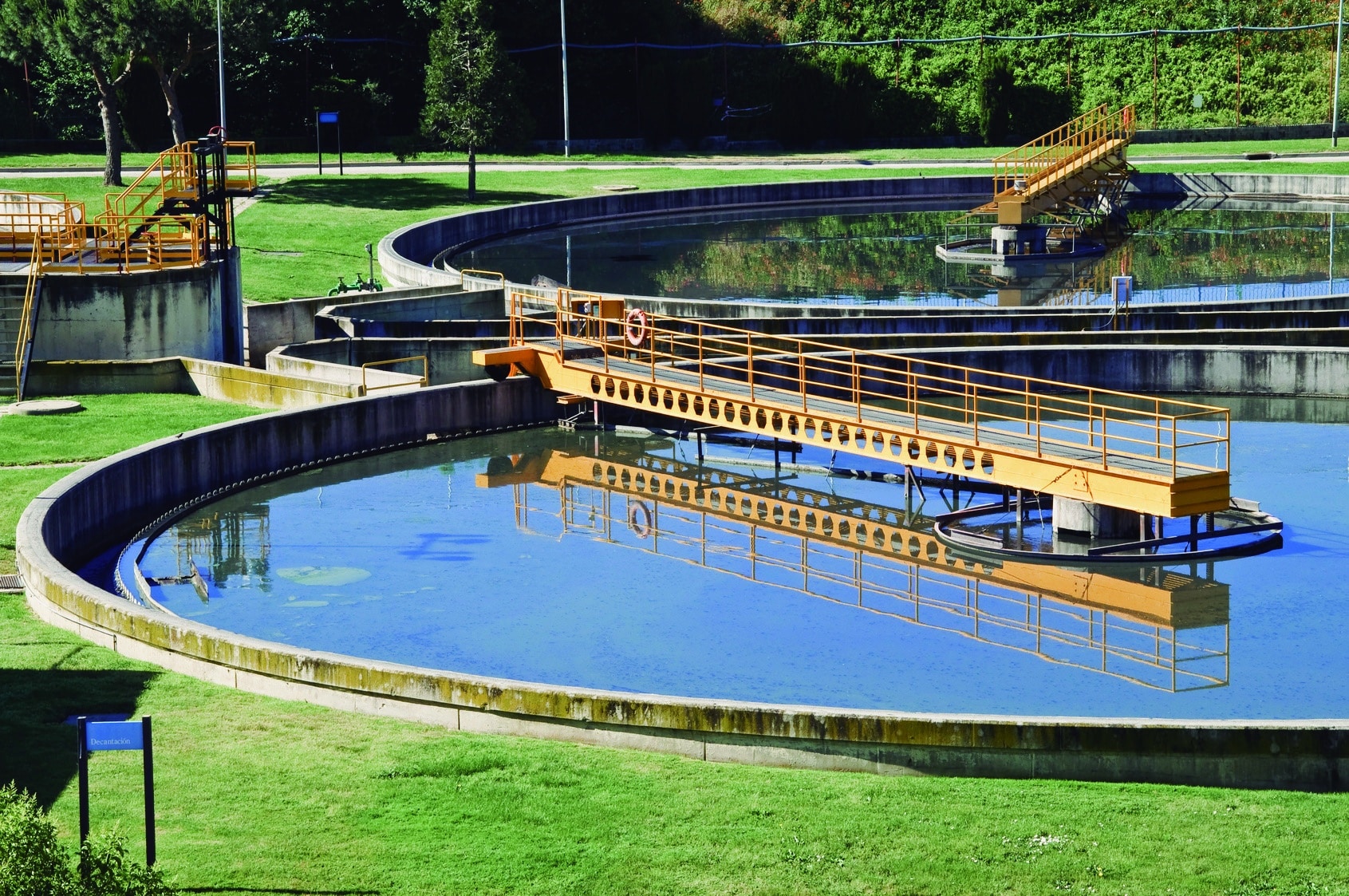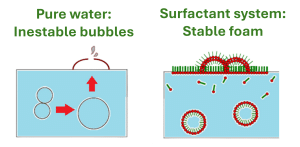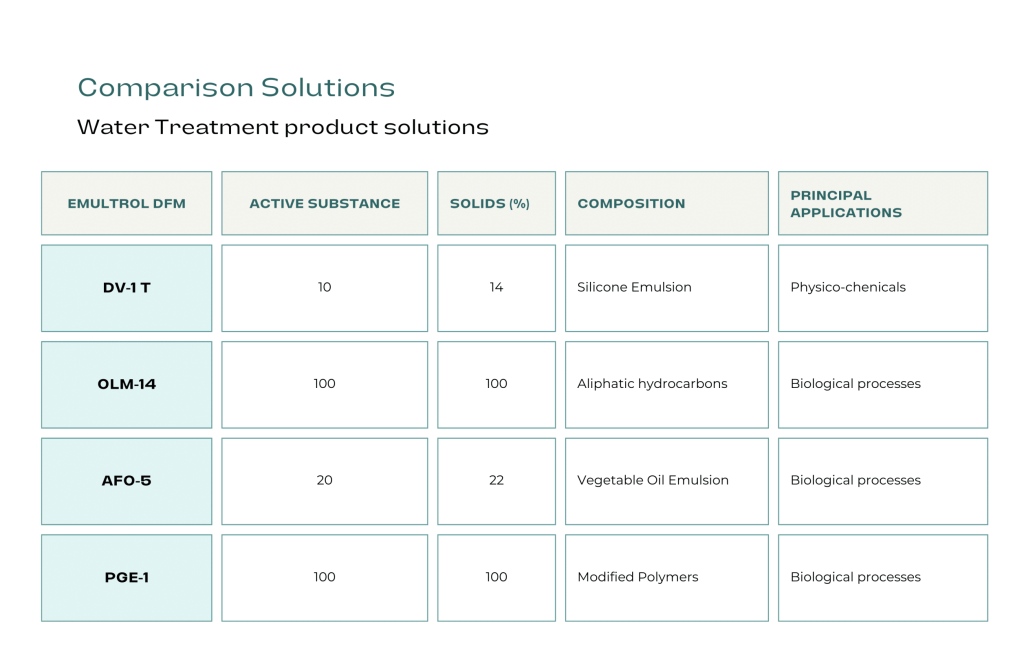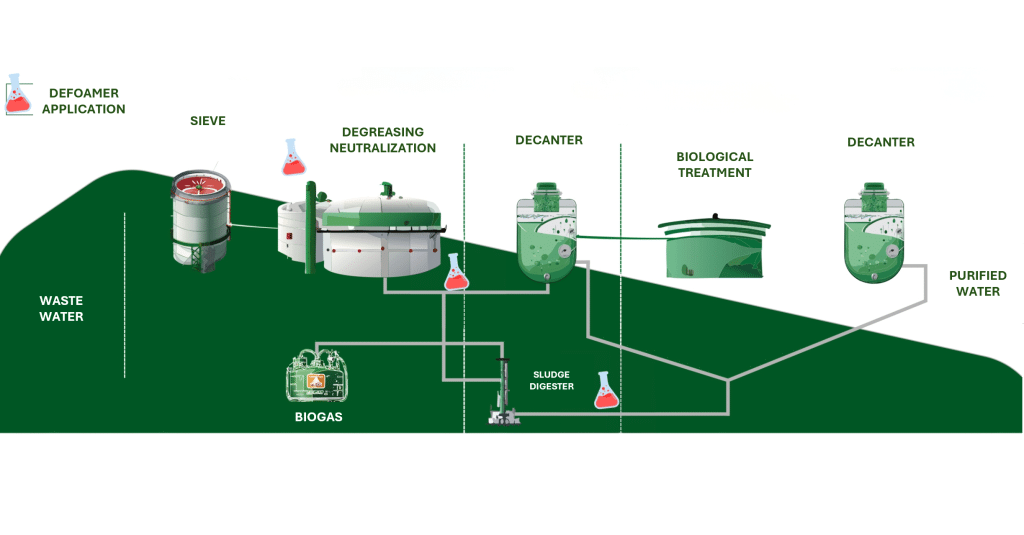1. Introduction.
1.1 Foaming
Foam is a stable dispersion of air and other gases in a liquid.
How to make foam dissapear to optimize the process?
- In pure liquids (water), gas bubbles rise to the surface and burst inmmediately
- In liquids with surfactants, gas bubbles stabilize, leading to the formation of foam on the liquid’s surface.
Foaming can be controlled using:
A DEFOAMER. An additive that destroys foam after it has been formed.
ANTI FOAM. An additive that eliminates micro foam and helps it rise to the surface.
1.2. Desestabilization of the foam. How to make the foam disappear to optimize the process?
The most effective mechanism in desestabilizing foam in waste water treatment is achieved with the dilution of effective defoamers.
An antifoam is a mixture of surfactants that desestabilizes and reduces the surface tension of the foam. When added to water, it alters the foam causing its collapase and the release of air, eliminating it in water treatment.
To be selected, the following must be achieved:
- The origin of the foam problem
- Water conditions (temperature, pressure, PH)
- Compatibility with other components
- Regulatory compliance
- A correct application for its effectiveness
1.3. Effect of foam on the waste water treatment operating system
- Impact on physicochemical efficiency due to the mixture of reagents.
- Alteration of the difference in densities, reducing the efficiency of flotation or sedimentation.
- The foam can pass into the final water purification, worsening its quality.
- Imbalance in biological processes: affect the balance of air, oxygen, heat and CO2, reducing the performance of the treatment.
- Air in water creates pockets of density that can cause cavitation in pumps, affecting the hydraulic pressure and stability of the circuits.
- Changes in preference and unwanted increase in filtration speed.
- Heat transfer.
- Effect on obtaining adequate mixtures of water, pollutants and reagents.
1.4. Costs generated by the appearance of foam
Labor. Increase in costs due to the need for corrective actions in the event of non-precise changes in the process.
Measurement accuracy. Reduced accuracy of parameter measurement and sampling systems.
Reagent consumption. Increase in the used of flocculants and coagulants.
Water quality. Growth of harmful parameters, requiring more investment in tertiary treatments.
Maintenance costs. Increase due to premature wear of mechanical components.
2. Types of Treatment
Treatment consists of physical, chemical and biological processes to remove contaminants. Three types of treatment are distinguished: primary or physicochemical, secondary or biological and tertiary. Some consider a fourth type of treatment prior to the primary one that includes the preliminary stages for the correct processing of the water.
Physicochemical or primary. It is used to reduce suspended elements in liquids, particularly in industrial waters. The most commom methods are flotation and coagulation-flocculation.
Flotation is applied when the matter suspended in the water is less dense than the water, such as oils, fats or emulsions. This is achieved by generating a large amount of air bubbles to displace the suspended elements to the surface. Coagulation-flocculation, on the other hand, is used for very small particles or those that settle very slowly. In this case, chemical substances are added that favor the coagulation of the particles, their flocculation and sedimentation. Other options for removing harmful substances from wastewater include precipitation, ion exchange, and UV treatment.
Biological or secondary treatment is often, but not necessarily, applied after physicochemical treatments and uses microorganisms that are responsible for actively degrading organic matter or biological content so that the elements to be removed are released from the aqueous medium.
Two different processes are distinguished depending on whether we treat matter based on oxidants or not, aerobic processes and anaerobic processes. In the former, aerobic microorganisms are incorporated to increase oxygen in the liquid through watering of solid surfaces, agitation and submerged aeration. In this, the disolve biodegrable substances serve as food for the incorporated microorganisms, becoming biomass of aerobic conditions, carbon dioxide and water. Next, nitrogen compounds are removed from the water being treated by nitrification and denitrification. Nitrification uses microorganisms to convert ammonium from waste water into nitrates, identrification reduces nitrate to nitrogen allowing the product to scape in a gaseous state into the atmosphere.
However, anaerobic processes, also fermentative or degrading, convert the processed organic matter into methane and carbon dioxide compounds by bacteria that degrade the solids that reach this stage. There is no oxidant-based compound in the methane compound, so the chemical reactions resulting from these processes release a small part of the energy, while the remaining energy remains in the methane compound.
Finally, tertiary treatment is carried out; this can be physicochemical or biological in nature and to refine the result of the composition of the effluent and the methods applied will be highly variable depending on the origin and destination of the water to be treated.
3. Concentrol solutions and how to use them
3.1. Concentrol solutions
- EMULTROL DV-1T. Emulsion defoamer with 10% silicone content.
- Properties: broad spectrum in water treatment
- Benefits: very stable, even in 50% dilution with water
- EMULTROL OLM-14. Hydrocarbon-based defoamer, 100% solid.
- Properties: broad spectrum
- Benefits: does not clog membranes
- EMULTROL AFO-5. Antifoaming emulsion based on 22% solid vegetable oils.
- Properties: used in biological media
- Benefits: 100% biodegradable. Does not clog membranes.
- EMULTROL PGE-1. Antifoamer with modified polymer base, 100% solids.
- Properties: used in biological media
- Benefits: 100% biodegradable. Does not clog membranes.
The composition and formulation of each of the solutions will depend on the processes to which the water is subjected and the physicochemical or biological treatments used such as agitation or aeration, biological reactors, control boxes and collectors, distillation and vacuum systems, etc.
Each chemical’s selection is associated with the presence of surfactants in the water, the engineering and the water quality required.
3.2. How to use them
- It is recommended to have the defoamer dosing system in the installation
- Its preventive and/or corrective use will depend on the problem of the foam in each case.
 4. Sustainability and respect for the environment
4. Sustainability and respect for the environment
Technology is of high importance in several sectors, since it is a tool that facilitates many processes and obtains relevant information about products. That is why it is necessary to update yourself with the latest technological advances. At Concentrol we are committed to development and exhaustive research with the aim of improving the productivity of our divisions and obtaining excellent product quality.
In the sector and family of products that concern us, such as defoamers, they intervene in many key points of industrial processes. Its use allows to increase the production capacity and the quality of the final products.
Improving processes with SVHC-free defoamers
As we have already mentioned in previous points, the control and reduction of foam in wastewater treatment improves the performance of its processes, thanks to the application of antifoamers suitable for each type of treatment.
All categories of additive products that we use in any industrial process are subject to their own EU regulation.
In it, in 2028, the Member States’ Committee (ED/61/2018) included substances D4, D5, D6, in the list of SVHC (Substances of Very High Concern) or SVHC (Substances of Very High Concern). This implies making it mandatory to declare them in the corresponding safety sheets, if the content of each of the defoaming products is equal to or greater than 0.1%.
Concentrol is a chemical company that has a strong commitment to the environment and health rooted in its DNA. It is for this reason that all its activity is carried out under the most demanding regulations, while continuously researching to improve its references by supporting a stable development of the working environment and the environment.
We develop and manufacture antifoaming additives with our own technology, committed to research and innovation, which allows us to control all products, offering references and solutions adapted to the specific needs of each application and customer.
The entire range of defoaming additives that Concentrol offers is totally free of SVHC components. This does not compromise the excellent efficiency or its compatibility in the different processes and final results.
We have a range of defoamers with an excellent value for money, offering the product high efficacy and stability of the effect of the defoamer over time. They are well compatible with different types of treatments and processes, avoiding the formation of unwanted side effects. They are easy to apply and always comply with all safety measures for people and the environment.






